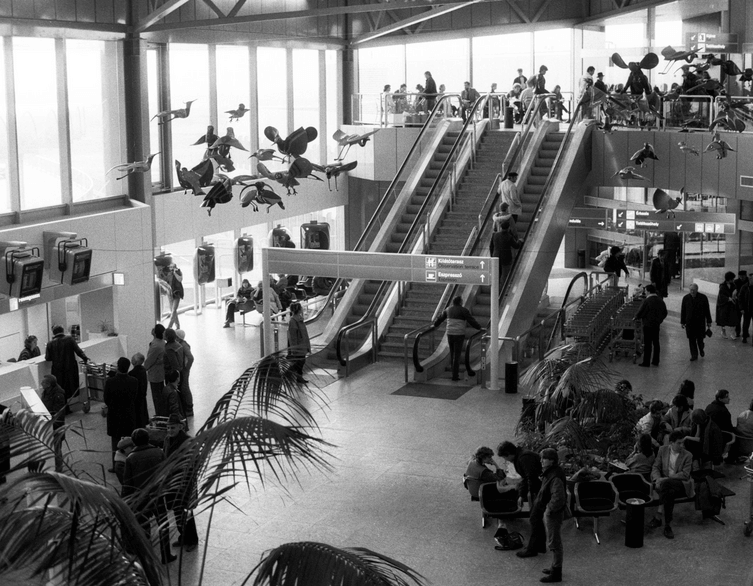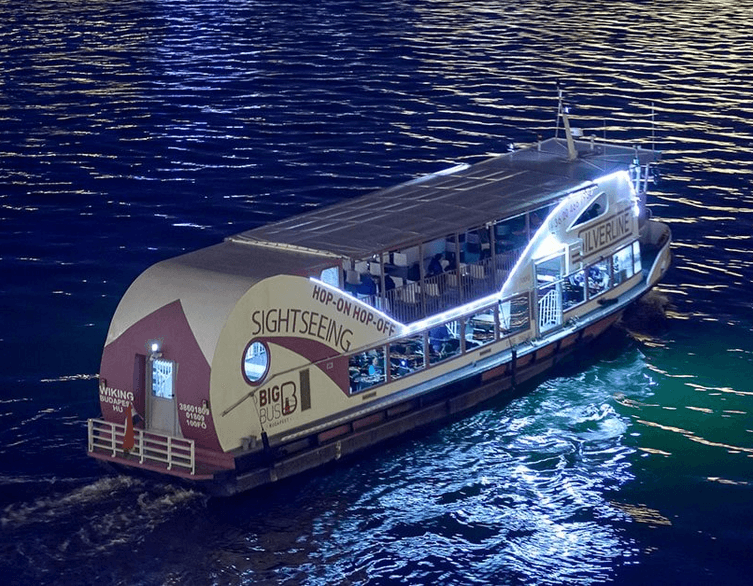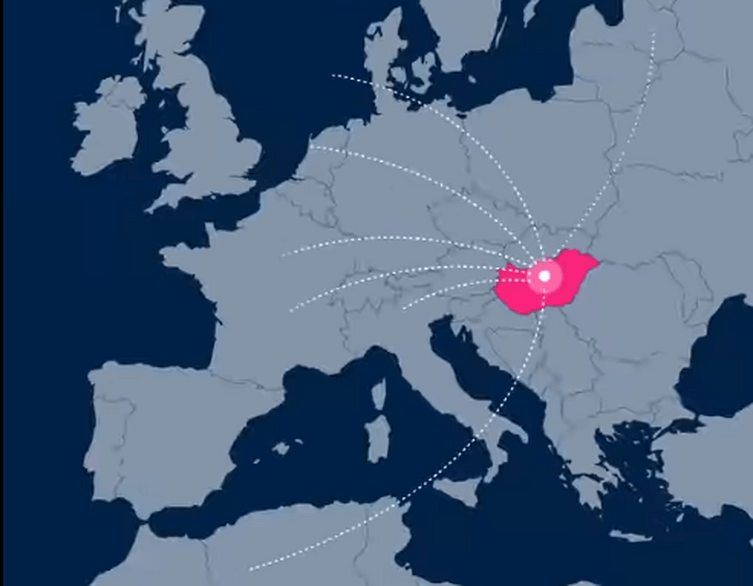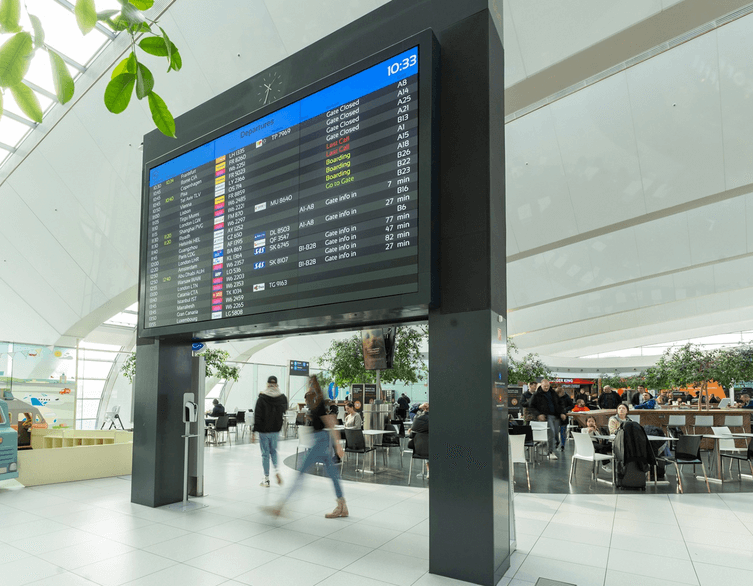Budapest Airport’s Terminal 2 Turns 40: From Paper Napkin Sketch to Modern Aviation Hub

Here’s a fun fact about one of Europe’s busiest airports that you probably didn’t know: the blueprint for Budapest’s Terminal 2—the building you’ll likely walk through when you fly into Hungary—was first sketched on a restaurant napkin. Seriously. Back in 1985, when the terminal opened its doors, it represented a massive leap forward for Hungarian aviation. Now, 40 years later, as the airport prepares for even more ambitious expansions including a game-changing railway connection and brand-new Terminal 3, it’s worth looking back at how this modern travel hub came to be and where it’s heading.
When Propeller Planes Gave Way to Jets
Budapest’s main airport has been located at Ferihegy (now officially called Ferenc Liszt International Airport) since 1950. The original terminal building worked just fine during the 1950s and 1960s, when commercial aviation was still relatively modest. Back when the airport was first designed in the late 1930s, aircraft were small propeller-driven machines carrying just a few dozen passengers. Fast forward to the 1970s, and suddenly jets capable of carrying 180 passengers were landing regularly at Budapest. The old building simply couldn’t handle the traffic anymore.
By the 1980s, the situation had become critical. A second runway was under construction, a new control tower was going up, and passenger numbers kept climbing. The infrastructure desperately needed updating, but there was one small problem: Hungary hadn’t built a passenger terminal in nearly 50 years. Nobody really knew how to do it anymore.
The Famous Napkin Sketch
In 1976, the Hungarian government approved plans for a new terminal and announced an architectural competition. Unfortunately, all the submissions were pretty disappointing. The problem wasn’t lack of talent—it was lack of experience. Without recent airport construction projects to draw upon, Hungarian architects simply didn’t have the specialized knowledge needed.
So Hungarian officials did something pragmatic: they asked for help from the West. Specifically, they brought in an architect from Frankfurt Airport as a consultant. After several visits to Budapest and lots of discussions, the breakthrough moment came during dinner at the legendary Gundel restaurant. Over the meal, the Frankfurt expert grabbed a paper napkin and sketched out what the new terminal should look like. That napkin drawing became the foundation for the final design, which was ultimately completed by the Hungarian firm UVATERV.
A Compact Marvel Opens
The resulting terminal—essentially what we now call Terminal 2A—featured a distinctive triangular shape. It employed what was then considered a very modern “compact terminal” design, meaning everything happened within one building rather than sprawling across multiple structures with long concourses. Aircraft parked directly adjacent to the building, keeping walking distances manageable for passengers.
The two-story design cleverly separated arriving and departing passengers, with 20 check-in counters on the departure level and six jet bridges connecting directly to aircraft. For planes parked at more distant positions, buses shuttled passengers to and from the terminal—a practice that continues today for some flights.
What really set Terminal 2 apart was how thoroughly modern it felt, especially by Hungarian standards of the mid-1980s. This was the first building in Hungary specifically designed to be fully accessible for people with disabilities from day one. The finishes, the passenger information systems, the technical solutions—everything created a distinctly “Western” experience that stood out dramatically in communist-era Hungary. One particularly clever innovation was an automated system that helped pilots park aircraft precisely in their designated spots.
An International Investment
Building Terminal 2 required serious money: 1 billion Hungarian forints plus 654 million Austrian schillings. The Austrian portion came as a loan from Western banks, and Austrian construction companies handled much of the actual building work. This international collaboration was relatively unusual for the time and reflected Hungary’s gradual opening to Western economic ties during the 1980s.
The grand opening happened on October 28, 1985, attended by high-ranking Communist Party officials, government ministers, and representatives from the Austrian embassy and various construction firms. The transportation minister proudly announced that the terminal could handle up to 1,000 passengers per hour and had been completed on schedule to “world-class standards.” The VIP guests were supposed to take a celebratory flight on a Tupolev Tu-154, but thick fog grounded the ceremonial aircraft. The first scheduled flight—arriving from Thessaloniki—touched down at 6:40 AM on November 1, 1985, followed by the first departure at 7:05 AM.
Not Everyone Moved In Right Away
Interestingly, Terminal 2 didn’t replace the old terminal immediately. Instead, only select airlines operated from the sparkling new facility—primarily Hungary’s state carrier MALÉV, along with Lufthansa, Air France, and Swissair. Other airlines continued using what became known as Terminal 1. Regular bus service connected the two terminals, and passengers could reach the new terminal by private car (with a new 460-space parking lot), public bus, or long-distance coach service.
Growing Pains and Expansions
As impressive as Terminal 2 seemed in 1985—designed for 2 million passengers annually—it didn’t stay spacious for long. By the late 1990s, expansion was urgently needed. The original building had been cleverly designed with future growth in mind, making it relatively straightforward to add Terminal 2B, which opened in December 1998. This expansion added over 30,000 square meters of space and capacity for another 3.5 million passengers annually.
In 2011, the SkyCourt building connected Terminals 2A and 2B, creating a unified complex with centralized security screening, shopping, dining, and business lounges. The modern SkyCourt transformed the passenger experience and boosted the combined terminal’s capacity to about 11 million passengers per year.
The Terminal 3 Revolution Takes Shape
Today, Ferenc Liszt International Airport handles between 15 and 17 million passengers annually—a far cry from the 2 million the original Terminal 2 was built for. The airport experienced the strongest passenger growth in Europe in October 2024, and passenger traffic has been climbing at an average annual rate of 14 percent. Airport officials expect to hit 20 million passengers by 2030 and potentially 40 million by 2040. To handle this explosive growth, Terminal 3 isn’t just desirable—it’s absolutely essential.
The Hungarian government made headlines in October 2025 by announcing a massive 2.5 billion euro investment package for airport infrastructure. They revealed that Terminal 3’s foundation stone will be laid in March 2026, with the entire project taking approximately eight years to complete. The terminal itself represents a 1 billion euro investment and will be developed in partnership with international investors, including Vinci Airports, which acquired a 20 percent stake in Budapest Airport when the facility returned to Hungarian state ownership.
Best deals of Budapest
Preliminary work is already well underway. Construction company STRABAG is currently moving 86,000 cubic meters of earth on the airfield side to prepare for a new apron that will accommodate 12 aircraft simultaneously. This earthwork project alone covers 36,000 square meters and includes challenging tasks like demining operations to clear World War II-era explosives, utility relocations, and building a massive 360-meter reinforced concrete retaining wall.
The design and development of Terminal 3 emphasizes sustainability, aligning with Budapest Airport’s ambitious goal of achieving net-zero emissions by 2030—a full 20 years ahead of the deadline set by Airports Council International. Airport CEO François Berisot emphasized that the terminal development must serve growing passenger numbers “with high quality and continuously expanding infrastructure” while meeting these environmental commitments.
The Game-Changing Railway Connection
Here’s where things get really exciting for travelers: Budapest is finally getting a proper fast rail link between the airport and downtown. For years, visitors arriving at Ferenc Liszt Airport have had limited options—taking the 100E airport bus, arranging an expensive taxi, or using ride-sharing services. That’s all about to change dramatically.
The new Budapest Airport Express Rail will connect Nyugati Railway Station, one of the city’s most central transportation hubs, directly to Terminal 2 in just 15 to 20 minutes. Trains will run every 5 to 10 minutes during peak periods, traveling at speeds up to 160 kilometers per hour along a dedicated 27-kilometer route. Ticket prices are expected to range between 3,000 and 4,000 Hungarian forints (approximately 8-10 euros)—significantly cheaper than taxis and far more convenient than current bus options.
What makes this project particularly clever is how it integrates with Hungary’s existing rail network. New tracks will only need to be built between Kőbánya (in Budapest’s 10th district) and the airport itself. From Kőbánya, the airport line will connect to the national railway system, meaning travelers from major Hungarian cities like Debrecen, Szeged, Győr, Székesfehérvár, and Nyíregyháza will be able to reach the airport with a single transfer-free connection. This transforms Budapest Airport into a genuine regional hub for Central Europe.
The airport station will likely be underground due to space constraints, and much of the construction within the airport boundaries will take place below ground level to minimize disruption to ongoing operations. Following requests from Budapest’s municipal government, the line will also include a stop at Rákosrendező station, improving connectivity for residents in outer Budapest districts.
The railway project is structured as an international concession investment worth approximately 1 billion euros. Rather than funding construction entirely upfront from the state budget, the government plans to engage private investors through a competitive tender process expected to launch soon. Construction could begin as early as 2026, with completion targeted for 2034-2035—coinciding with the opening of Terminal 3.
The New Expressway
But the government isn’t stopping with rail infrastructure. An additional 500 million euros will fund construction of a new 12-kilometer expressway, mostly six lanes wide, connecting outer Üllői Road directly to the airport. This addresses a longstanding complaint: the current road route forces drivers through congested urban streets with numerous traffic lights before reaching the airport.
Construction on the expressway is scheduled to begin in late 2026 and take approximately two to two-and-a-half years. The project affects 356 properties, with 265 requiring expropriation to secure the necessary right-of-way. While this will undoubtedly cause some disruption and controversy, the improved road connection should significantly reduce travel times for passengers arriving by car, taxi, or bus.
What This Means for Visitors
For tourists planning to visit Budapest, these developments promise a transformation in how you’ll experience arriving in Hungary’s capital. Imagine stepping off your transatlantic flight, clearing customs, and hopping on a sleek airport express train that whisks you to the heart of Budapest in less time than it takes to watch a sitcom episode. Within 20 minutes of leaving the terminal, you could be standing in front of Nyugati Railway Station, just steps from iconic sights like the Parliament Building, St. Stephen’s Basilica, and the Danube riverfront.
The convenience factor alone makes Budapest significantly more competitive with other European capitals. Cities like Vienna, London, and Paris have long offered fast rail connections to their airports. Budapest joining this club removes a major inconvenience that has frustrated travelers for decades.
Terminal 3 will bring modern facilities comparable to the world’s best airports—spacious check-in areas, efficient security processing, comfortable waiting areas, improved dining and shopping options, and better connections between gates. The current Terminal 2, while functional, struggles during peak periods with crowded security lines, limited seating, and a somewhat dated passenger experience. Terminal 3 will address all these issues while doubling the airport’s capacity.
A Living Legacy
Forty years after that napkin sketch at Gundel restaurant became reality, Terminal 2 continues serving millions of passengers annually. While it’s been expanded, renovated, and connected to newer structures, the core triangular building still handles much of Budapest’s air traffic. The innovations that seemed so impressive in 1985—accessible design, centralized passenger processing, modern technical systems—have become standard expectations, but they were genuinely groundbreaking at the time.
As Terminal 3 takes shape over the coming decade and the railway connection materializes, Budapest’s airport will undergo another transformation as dramatic as the one that occurred in 1985. The airport’s evolution from a modest Cold War-era facility to a major European aviation hub reflects Hungary’s own journey over the past four decades—from a communist state cautiously engaging with the West to a fully integrated European Union member connecting travelers to destinations worldwide.
So next time you’re standing in Terminal 2 waiting for your flight, maybe grab a coffee and appreciate that you’re in a building that started as a sketch on a napkin, opened with fanfare during the final years of communist rule, and has been welcoming visitors to Hungary for four decades. And if you’re flying through Budapest after 2034, you’ll experience the next chapter of this story as Terminal 3 opens its doors and that express train glides you effortlessly between downtown Budapest and one of Central Europe’s most ambitious airport developments. The future of Budapest aviation is looking remarkably bright.
Related news





















